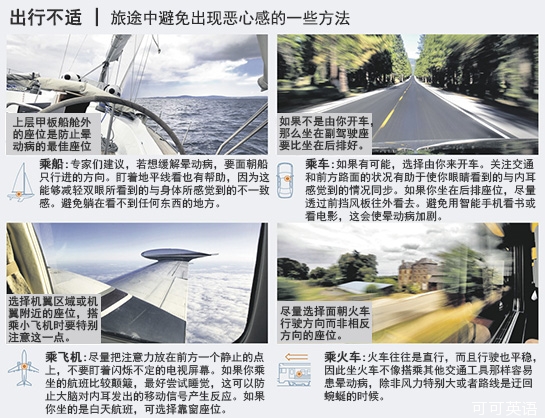
Researchers from the Navy, the National Aeronautics and Space Administration and academia are studying causes and potential treatments of motion sickness, hoping to formulate better products for situations that range from the extreme (space!) to the mundane (road trip to Grandma's, anyone?).
美國海軍、美國國家航空航天局(National Aeronautics and Space Administration,簡稱“NASA”)以及學(xué)術(shù)界的研究人員對暈動病的成因及潛在療法進(jìn)行了研究,希望能生產(chǎn)出適用于從極端情形(比如太空!)到普通情形(比如坐車去奶奶家,有沒有人有此經(jīng)歷?)等各類情形的高效藥品。
There's nothing quite like motion sickness to ruin summer travel, with symptoms including dizziness, headache, nausea and most unfortunately, vomiting. Some 25% to 40% of the population suffers from some degree of motion sickness, depending on the mode of transportation.
再沒什么事情能像暈動病一樣毀掉你的夏日旅行了,它會讓你出現(xiàn)頭暈、頭痛、惡心等癥狀,情況最糟糕時還會引發(fā)嘔吐。根據(jù)交通方式的不同,大約有25%到40%的人在某種程度上受到暈動病的折磨。
At Siena College, in Loudonville, N.Y., researchers have studied the effectiveness of ginger capsules, facial cooling and listening to music as a distraction for lessening symptoms and physiological responses to motion sickness.
關(guān)于服用生姜膠囊、冷敷臉部以及通過聽音樂分散注意力來緩解暈動病的癥狀及其引發(fā)的生理反應(yīng)的效果,紐約州勞頓維爾(Loudonville)錫耶納學(xué)院(Siena College)的研究人員也進(jìn)行了研究。
NASA and the Navy are collaborating with pharmaceutical company Epiomed Therapeutics, of Irvine, Calif., to develop a nasal spray containing scopolamine, a drug currently used in a prescription-only patch for those prone to seasickness. Researchers say the drug's strong possible side effects, such as drowsiness and dry mouth, would be significantly reduced with a nasal spray.
NASA、美國海軍與加州爾灣(Irvine)的制藥公司Epiomed Therapeutics展開合作,研制了一種含莨菪鹼的鼻噴霧劑。目前莨菪鹼被用于一種僅能憑處方購買的治療易暈船患者的貼片中。研究人員稱該藥物可能具有使人困倦和口干等強烈的副作用,而使用鼻噴霧劑方式可大幅減輕這些副作用。
Part of the difficulty with devising treatments is that experts don't know exactly what causes motion sickness. The prevailing belief is it is caused by a sensory mismatch between the visual and vestibular systems. The vestibular system, which is part of the inner ear, monitors movement and helps control balance.
制定出暈動癥療法并不容易,部分原因是由于專家們并未確切了解它的成因。人們普遍認(rèn)為它是由視覺系統(tǒng)與前庭系統(tǒng)感覺上的不一致所引發(fā)的。前庭系統(tǒng)屬于內(nèi)耳的一部分,它監(jiān)測身體的移動并幫助控制身體的平衡。
In other words, our inner ear tells our brain that we are moving, but our eyes tell us we aren't, or vice versa. 'When one of these is telling you you're in motion and the other one is telling you you're sitting, the brain gets confused with the mixed signals, and it causes this sense of sickness,' says Abinash Virk, director of the travel and tropical medicine clinic at Mayo Clinic in Rochester, Minn.
換句話說,當(dāng)我們的內(nèi)耳發(fā)出信號,告訴大腦我們正在移動時,我們的眼睛卻告訴說我們并沒有移動,反之亦然。明尼蘇達(dá)州羅切斯特(Rochester)梅約醫(yī)院(Mayo Clinic)旅行醫(yī)學(xué)與熱帶醫(yī)學(xué)門診部的主任阿比納什•沃爾克(Abinash Virk)說:“當(dāng)其中一方告訴你說你正身處運動中,而另一方卻告訴你說你正坐著,大腦就會被這些混雜不一的信號搞糊涂,這就會引發(fā)惡心感。”
What remain unknown are the reasons why the mismatch causes some individuals to react adversely. One long-standing theory is that the reactions are triggered by the brain's false identification of a toxin in the body, with nausea and vomiting a protective response to get rid of it.
而眼下依然未知的是,為什么感覺不一致會導(dǎo)致某些人產(chǎn)生不良反應(yīng)。一個由來已久的說法是,這些反應(yīng)產(chǎn)生的原因是大腦對身體中的一種毒素做出錯誤辨認(rèn),從而以惡心和嘔吐作為消除毒素的保護(hù)性反應(yīng)。
Another theory is that body sway, or the change in a person's movements over short time intervals, can explain a propensity to get motion sickness. In Tom Stoffregen's lab at the University of Minnesota, the kinesiology professor measures each subject's body sway over a short period. He has found that individuals who are more susceptible have a more-erratic sway during and even before they are exposed to any stimulation.
另一種解釋是,身體的晃動或是身體在短暫時間間隔內(nèi)的移動變化是人們易于患暈動病的原因。湯姆•施托夫雷根(Tom Stoffregen)是明尼蘇達(dá)大學(xué)(University of Minnesota)的運動機能學(xué)教授,他在自己的實驗室中測算了每名受試者在一小段時間內(nèi)的身體晃動情況。他發(fā)現(xiàn),更容易得暈動病的人在受刺激期間的身體晃動較不穩(wěn)定,甚至在受到刺激之前就會如此。
Dr. Stoffregen uses a force plate, a glorified bathroom scale with pressure sensors, to take measurements of body movement as often as 200 times a second. He studies people both in a lab simulator and on ships.
施托夫雷根使用了一塊測力板和一臺帶壓力傳感器的體重秤,以每秒多達(dá)200次的速率測算身體的動作。他在實驗室的模擬裝置中以及輪船上進(jìn)行了他的研究。
In a forthcoming study to be published in the online journal PLOS ONE, Dr. Stoffregen tested the body sway of 35 cruise passengers aboard a ship in the Caribbean before departure. Passengers then reported the intensity of their seasickness. He found a link: Those who reported getting more sea sickness had more body sway at the dock.
他在加勒比海一艘游輪上測試了船上35名游客在出發(fā)前的身體晃動情況,這些游客后來報告了他們的暈船程度。他發(fā)現(xiàn)其中存在關(guān)聯(lián):那些報告自己暈船程度較重的人,他們在碼頭時的身體晃動頻率就比較高。該項研究即將發(fā)表于《公共科學(xué)圖書館•綜合》(PLOS ONE)雜志的網(wǎng)絡(luò)版。












